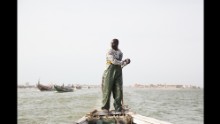In March, Greta Rybus spent a month working on a photo series in Saint-Louis, which is called Ndar in the Wolof language. It's about 250 kilometers (155 miles) north of Senegal's capital, Dakar. Her photo series focuses on the effects of climate change on two communities: the coastal community of fishermen and the inland community of herders and farmers.
It
was at dawn one morning when Rybus said she really realized the extent
to which environmental conditions impact these communities. That day,
Rybus woke up with the intent of simply photographing the fishermen as
they prepared their boats. That never happened.
"(There)
ended up being a pretty high tide that day ... (that) was starting to
eat up several homes," Rybus said. "I was watching people move their
furniture and TVs and all of their belongings out the front of the
house, while the back of the house just fell into the ocean."
As
this happened, Rybus said community members -- from little kids to
older women and men -- were rushing to support the shore with fishing
nets and chunks of concrete in bags.
"I felt like I had stumbled onto a breaking news scene," she said.
This
situation is seen in photo No. 7 in the gallery above, where a man
looks out an open door. Instead of seeing what was once a room, his
sight is flooded with the reality of water consuming part of his home.

While there is too much water on the
coastline, causing erosion and wiping out homes, Rybus said that inland,
there is too little water. This notion of too little and too much is
achieved aesthetically and compositionally in Rybus' photo series as
well. She notes how some of the photos feel very sparse while others
feel very claustrophobic.
Those who
live inland rely heavily on the rainy season. They used to be able to
predict when there would be rain, but Rybus said that because rain has
now become so inconsistent and infrequent, it is affecting people's
abilities to cultivate crops and feed their animals.
In
some cases, climate change has become so detrimental to people's
livelihoods that they have to find other means of making a living, such
as by taking jobs as drivers in the city or working for others in
neighboring towns.
No comments:
Post a Comment